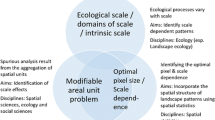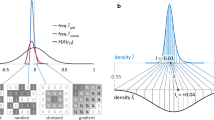Abstract
Context
The scope of a measurement is the ratio of the range (or extent) to the resolution. Scope can also be defined as the number of steps in a measurement instrument given the step size or the distance between two points on a space-time diagram. Scope differs from scale in that it is dimensionless and thus provides a means for comparability across studies.
Objectives
This perspective argues that advancing a science of scaling in landscape ecology can benefit from acknowledging and embracing the concept of scope to facilitate replications and provide linkages to scaling laws.
Methods
Scope is defined and linked to existing focii on scale in landscape ecology. A simple case study demonstrates how landscape metrics computed for several extent-to-grain ratios are more similar according to scope than either grain or extent.
Results
Metric distributions naturally group according to scope, with same/similar scopes displaying more similar means and distributions. Distribution shapes also show similarities according to scope, supporting the use of scope for comparisons and replications.
Conclusions
Recommendations for moving forward include setting the scope of a study based on the phenomenon under investigation, reporting grain and extent to permit scope calculations, and undertaking comparisons and replications based on scope.


Similar content being viewed by others
Data availability
Metric data for the case study are available at: github.com/amyfraz/scope.
Code availability
code for processing the case study data is available upon request.
References
Argañaraz JP, Entraigas I (2014) Scaling functions evaluation for estimation of landscape metrics at higher resolutions. Ecological informatics 22:1–12
Carpenter SR, Chisholm SW, Krebs CJ, Schindler DW, Wright RF (1995) Ecosystem experiments. Science 269(5222):324–327
Cushman SA, Landguth EL (2010) Scale dependent inference in landscape genetics. Landscape Ecol 25(6):967–979
Cushman SA, McGarigal K (2008) Landscape metrics, scales of resolution. Designing green landscapes. Springer, Dordrecht, pp 33–51
Forman RTT, Godron M (1981) Patches and structural components for a landscape ecology. BioSci 31:733–740
Frazier AE (2014) A new data aggregation technique to improve landscape metric downscaling. Landscape Ecol 29(7):1261–1276
Frazier AE (2016) Surface metrics: scaling relationships and downscaling behavior. Landscape Ecol 31(2):351–363
Frazier AE, Kedron P (2016) Impact of compositional and configurational data loss on downscaling accuracy. In: 12th international symposium on spatial accuracy assessment in natural resources and environmental sciences, Accuracy 2016
Frazier AE, Kedron P, Ovando-Montejo GA, Zhao Y (2021) Scaling spatial pattern metrics: impacts of composition and configuration on downscaling accuracy. Landscape Ecology
Hargrove WW, Pickering J (1992) Pseudoreplication: a sine qua non for regional ecology. Landscape Ecol 6(4):251–258
Kedron P, Frazier AE, Trgovac AB, Nelson T, Fotheringham AS (2019) Reproducibility and replicability in geographical analysis. Geographical Analysis. https://doi.org/10.1111/gean.12221
Kleiber M (1961) The fire of life. An introduction to animal energetics. John Wiley & Sons, Inc., New York: London
Levin SA (1992) The problem of pattern and scale in ecology: the Robert H. MacArthur award lecture. Ecology 73(6):1943–1967
McGarigal K, Wan HY, Zeller KA, Timm BC, Cushman SA (2016) Multi-scale habitat selection modeling: a review and outlook. Landscape Ecol 31(6):1161–1175
McGarigal K, Cushman SA, Vojta C, Reagan C (in press). Quantifying terrestrial habitat loss and fragmentation: a protocol. U.S. For. Serv. Gen. T,·ch. Repl. RM-GTR-xxx
Mercer WB, Hall AD (1911) The experimental error of field trials. J Agri Sci 4(2):107–132
Odgaard BV (1999) Fossil pollen as a record of past biodiversity. J Biogeogr 26(1):7–17
O’Neill RV, Hunsaker CT, Timmins SP, Jackson BL, Jones KB, Riitters KH, Wickham JD (1996) Scale problems in reporting landscape pattern at the regional scale. Landscape Ecol 11(3):169–180
Riitters KH, Coulston JW, Wickham JD (2012) Fragmentation of forest communities in the eastern United States. For Ecol Manag 263:85–93
Schneider DC (1994) Quantitative ecology: spatial and temporal scaling. Elsevier
Schneider DC (1998) Applied scaling theory. Ecological scale: theory and applications, 253-270
Schneider DC (2001a) Spatial allometry. Scaling Relations in Experimental Ecology. Columbia University Press, pp 113–154
Schneider DC (2001b) The rise of the concept of scale in ecology: The concept of scale is evolving from verbal expression to quantitative expression. Bioscience 51(7):545–553
Schneider DC (2009) Quantitative Ecology (2nd Edition). Elsevier Academic Press. eBook ISBN: 9780080925646
Turner MG, O’Neill RV, Gardner RH, Milne BT (1989) Effects of changing spatial scale on the analysis of landscape pattern. Landscape Ecol 3:153–162
Wiens JA (1989) Spatial scaling in ecology. Funct Ecol 3(4):385–397
Wu J (2004) Effects of changing scale on landscape pattern analysis: scaling relations. Landscape Ecol 19(2):125–138
Wu J (2007) Scale and scaling: a cross-disciplinary perspective. In: Key topics in landscape ecology. Cambridge University Press, pp 115–142
Acknowledgements
This work was supported, in part, by U.S. National Science Foundation grant #1934759.
Funding
This work is supported by U.S. National Science Foundation Grant #1934759.
Author information
Authors and Affiliations
Contributions
A.E.F. conceived of the idea, performed all data processing and analysis, wrote, and edited the entire manuscript.
Corresponding author
Ethics declarations
Conflict of interest
Nothing to disclose.
Ethical approval
Not Applicable.
Consent to participate
Not Applicable.
Consent for publication
The author consents to publication.
Additional information
Publisher’s Note
Springer Nature remains neutral with regard to jurisdictional claims in published maps and institutional affiliations.
Rights and permissions
About this article
Cite this article
Frazier, A.E. Scope and its role in advancing a science of scaling in landscape ecology. Landsc Ecol 38, 637–643 (2023). https://doi.org/10.1007/s10980-022-01403-1
Received:
Accepted:
Published:
Issue Date:
DOI: https://doi.org/10.1007/s10980-022-01403-1




